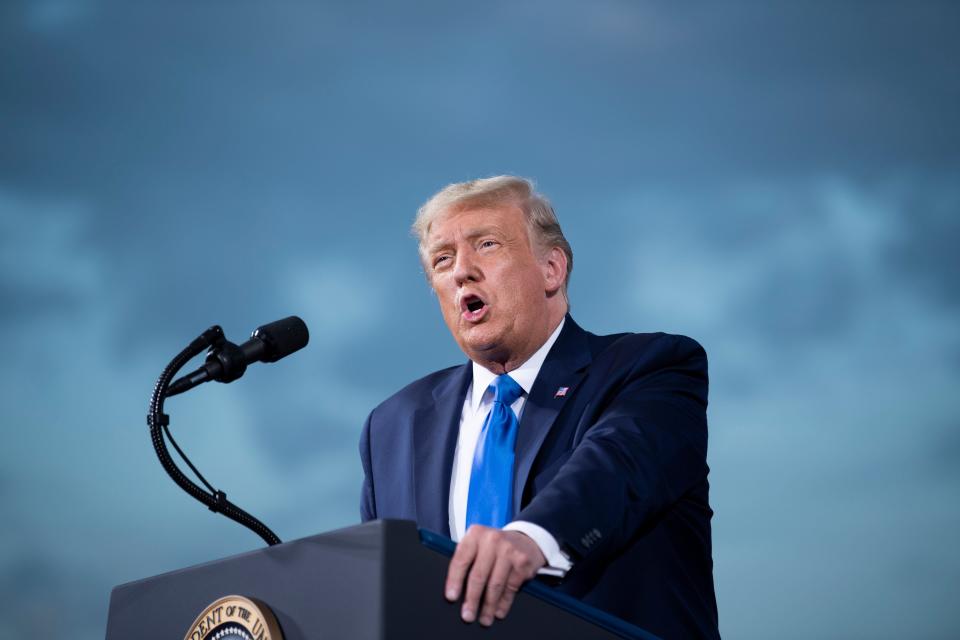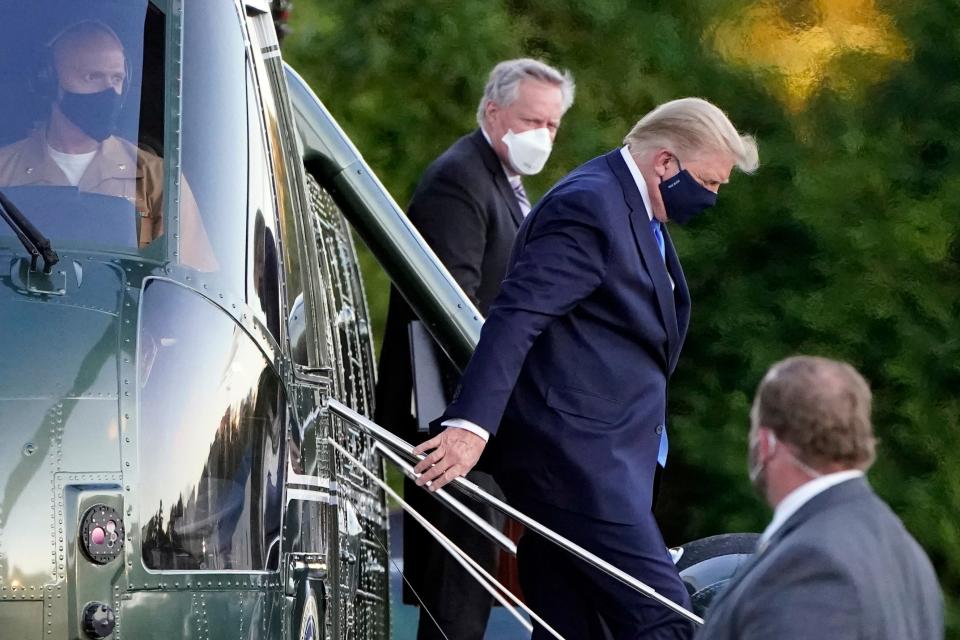Coronavirus pandemic highlights President Trump's broken health care promises
During the 2016 campaign, Donald Trump promised "great health care" for any American who is sick, and at affordable prices.
“We’ll be terminating Obamacare and we’ll be replacing it with so many different options, but you’ll have great health care at a fraction, a fraction of the cost and it’ll be great,” Trump said from the Robarts Arena stage in Sarasota, Florida, during one of the last rallies of his campaign.
But nonpartisan experts say health care costs have continued to rise during Trump’s administration, raising concerns about the affordability of care when it is most needed – in the midst of a global pandemic.
More than 8.6 million Americans have been infected with the virus, more than 460,000 have been hospitalized with the disease, including the president, and millions have lost their health insurance after being laid off, leading to intense interest in the health of the nation, the medical system that cares for sick individuals and the costs associated with it.
After testing positive for COVID-19 on Oct. 2, Trump received access to the best medical care in the world at Walter Reed National Military Medical Center, where he spent three days.
'Don't be afraid of it': Trump returns to White House after hospitalization for COVID-19
“The bottom line, we have not, in the private or public sector, initiated new initiatives to control health care spending,” said Harvard University professor Michael Chernew, an expert on health care economics.
And as health care costs have continued to rise, so have insurance premiums and out-of-pocket costs for families.
“People are typically paying more out of pocket and getting somewhat less generous coverage,” Chernew said. “They’re paying more out of pocket when they go to get care and when they pay for insurance.”
Trump took a series of actions on health care that he touts as major efforts to control costs, but there are doubts about whether his plan will accomplish much. Critics see it as a blatant attempt to make it look like he is doing something on an issue voters care about, despite falling well short of his campaign promises.
Trump’s 2020 pitch
Trump’s health care plan rollout came on the eve of a campaign swing through Florida.
During the health care event, Trump signed an executive order protecting people with preexisting conditions from being charged more for insurance, even though they already are protected under the Affordable Care Act, and promised to send Medicare beneficiaries cards worth $200 to help pay for prescription drugs. He also touted a proposal to tie Medicare drug prices to those in other nations with cheaper drug costs.
Executive order: Trump promises to protect those with pre-existing conditions, already safe under ACA

Florida has 4.6 million people on Medicare out of 33 million beneficiaries nationwide and more people who get government-subsidized insurance through the ACA (nearly 2 million) than any other state.
Democrats are hammering Trump for his administration’s ongoing efforts to repeal the ACA, raising the issue again as the president appoints Amy Coney Barrett to the U.S. Supreme Court, where she could be a pivotal vote on whether the law stands.
Trump’s health care speech seemed like an effort to blunt some of that criticism and show voters he is still focused on the issue.
Fox News anchor Chris Wallace quizzed Trump about his health care plan during the first presidential debate.
More: Read the full transcript from the first presidential debate between Joe Biden and Donald Trump
“You, in the course of these four years, have never come up with a comprehensive plan to replace Obamacare,” Wallace said. “And just this last Thursday, you signed a largely symbolic executive order to protect people with pre-existing conditions, five days before this debate. So my question sir is, what is the Trump healthcare plan?”
Trump responded that there is “nothing symbolic” in his plan.
“This is big stuff,” he said.
But he’s been making similar promises for years with little to show for it.
Fact check: The pre-existing conditions debate
Costs rise
Every year the Kaiser Family Foundation does a large survey of health insurance costs.
The surveys show that average premiums for employer-sponsored plans – which cover about half of the non-elderly population, or more than 150 million people in 2019 – increased by 12% for an individual and 13% for a family between 2016 and 2019.
Employers pick up most of the costs, but the share of a family plan paid by an individual worker was $6,015 on average in 2019, which is up $738 from 2016. That’s an extra $62 a month workers are paying for health insurance out of their own pockets since Trump took office.
Health insurance premiums are rising, in part, because the costs of visiting a doctor, going to the hospital and filling a prescription have gone up.
Hospital costs have risen the fastest, said Kaiser Vice President Cynthia Cox.
There have been efforts to tackle these costs, largely by encouraging competition and increased price transparency. But they haven’t made a big dent, experts say, and the focus typically has been elsewhere.
More: Right after Trump blamed high drug prices on campaign cash, drugmakers gave more
“A lot of politicians, including Trump but also Bernie Sanders, have focused on prescription drugs,” Cox said. “Maybe because it’s an easier target… really the bigger driver of health care spending is hospitals.”
“In fairness to president Trump there’s just not a lot of action there from either party,” Cox added.
Trump has pushed a series of prescription drug proposals, and his administration, citing consumer price index data, has touted a brief dip in prescription drug prices.
But overall drug prices have gone up during Trump’s presidency, said Commonwealth Fund President David Blumenthal, a doctor and health policy expert who served in the U.S. Department of Health and Human Services under President Barack Obama.
“There was one year during his term when drug prices did go down,” Blumenthal said. “But in aggregate over the last four years they’ve increased by 11 percent.”
Other ideas pushed by the Trump administration include promoting so-called “short term” insurance plans that are cheaper and typically provide less coverage. But overall, Chernew said none of the reforms pitched in the last few years “have moved the needle very much” in terms of controlling costs.
Many of Trump’s early health care promises centered around replacing the Affordable Care Act, but that never happened.
ACA repeal fails
During the 2016 campaign Trump repeatedly cited premium increases among ACA plans and limited competition among insurers to describe the system was failing, and to argue it should be replaced.
But his administration never proposed an alternative, and experts say the proposals put forward by GOP leaders in Congress did not live up to Trump’s promise that he would provide great health care at a fraction of the cost.
In general, some people might have paid less for health insurance under the GOP plans, such as younger individuals. But some older individuals likely would have paid more, and millions of other people would have lost their insurance entirely, Cox said.
“On average more people would have paid more” for health care under the GOP’s ACA replacement plans, Cox said.
Trump’s push to repeal the ACA ultimately failed in 2017, when three Republican senators broke ranks and voted with Democrats to preserve the law.
Meanwhile, the ACA insurance market began to stabilize under Trump. Competition improved and prices have been relatively stable, experts say. That’s despite efforts to undermine the law, including a provision in the 2017 GOP tax cut package that repealed the individual mandate that everyone buy insurance, which was supposed to help increase the risk pool by getting younger, healthier individuals to buy plans.
“For the most part the ACA’s been reasonably resilient,” Chernew said.
Pandemic heightens concerns
Just as the battle over the ACA was subsiding, the coronavirus pandemic made health care a dominant issue in American politics again.
More than 414,000 Americans have been hospitalized with COVID-119, according to The COVID Tracking Project. The Florida Department of Health reports 45,000 people have been hospitalized in the state. Such treatment is expensive.
Trump recently became the most famous COVID-19 patient. A New York Times analysis estimated his three days of hospital care cost around $100,000.

The federal government is picking up the tab for the president's care, but many sick individuals pay a significant portion of their medical costs out of pocket.
According to the U.S. Census Bureau, 28.6 million Americans didn’t have health insurance in 2018, including 2.7 million Floridians. Various studies have estimated that millions of Americans lost their health insurance during the big wave of recent layoffs sparked by the coronavirus crisis.
But even those with insurance may struggle to afford the cost of care.
A Commonwealth Fund survey found that 46% of privately insured adults have coverage with a deductible of $1,000 or more, up from 22% in 2010.
Blumenthal said his organization determined that about 43% of adults are inadequately insured, meaning they have plans that leave them vulnerable to paying more than 5% of their income towards health care in a given year.
“That leads to a lot of medical insecurity,” he said.
This article originally appeared on Sarasota Herald-Tribune: President Trump's broken health care promises highlighted amid COVID